This melt-in-your-mouth Chashu recipe is quite easy to make at home. Braised low and slow in a sweet and savory sauce, these tender slices of pork belly can now top your next ramen or rice bowl. It’s the most fulfilling reward for any pork lover.
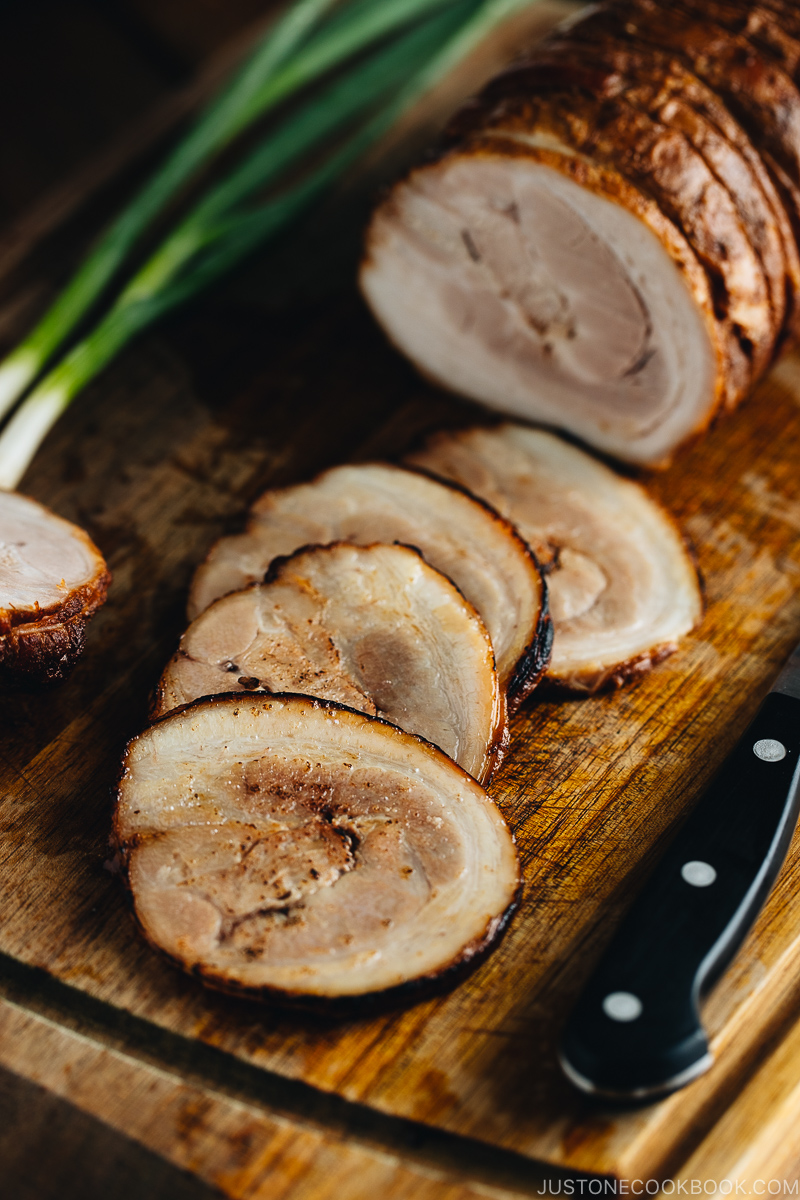
What is your favorite ramen topping? For most people, including Mr. JOC, it is the melt-in-your-mouth, juicy, and flavorful slices of braised pork belly called chashu (チャーシュー). These tender slices go so well with perfectly soft-boiled and marinated ramen egg (ajitsuke tamago), which is my favorite ramen topping!
It’s surprisingly easy to make my Chashu recipe at home. The prep time and active cooking time aren’t too long, but you do need patience to wait out the overnight resting period. The reward is a super tender chashu that tastes heavenly! I’ll guide you through the process with my step-by-step instructions.
Table of Contents
What is Chashu?
Chāshū (チャーシュー) is a Japanese adaptation of the famous Chinese barbecued pork dish called char siu (叉燒). We prepare the pork belly for chashu by rolling it into a log (or make the non-rolled version and skip rolling). Then, we braise it over low heat in a sauce seasoned with soy sauce, sake, and sugar.
In Japanese, we sometimes call chashu nibuta (煮豚), literally simmered/braised pork, as opposed to yakibuta (焼豚), which means barbecued pork. The Japanese enjoy chashu as a topping for ramen and other noodles, but also over steamed rice in a rice bowl dish called chashu don.
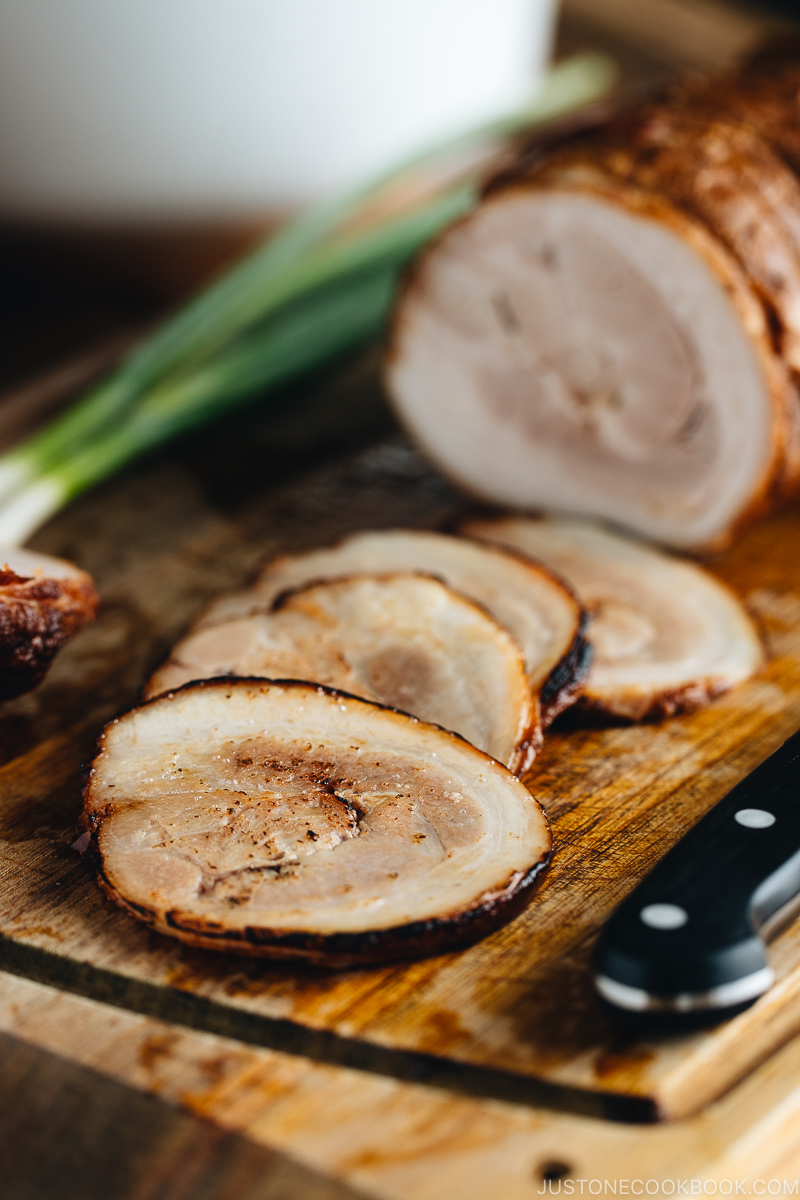
Chinese Char Siu vs. Japanese Chashu
You have probably seen the slabs of barbecued pork hanging in Chinese deli shop windows. Compare this dish with chashu and you’ll notice significant differences in their seasoning, cooking method, and final texture.
- Seasoning: While chashu uses Japanese pantry seasonings, Chinese char siu is marinated in soy sauce, honey, hoisin sauce, rice wine, five-spice powder, and red food coloring.
- Cooking method: Unlike chashu that’s braised low and slow, char siu is roasted in a covered oven or barbecued over a fire.
- Texture: Char siu offers a firm bite with marked, smoky grilled flavor. In contrast, Japanese chashu has a succulent and fork-tender texture.
Ingredients for Chashu
- pork belly block – for skin-on pork, you’ll need to remove the rind
- Tokyo negi (naga negi; long green onion) – the green part only; substitute with leek or green onions
- fresh ginger slices
- neutral oil – for searing
- sake
- soy sauce
- water
- sugar
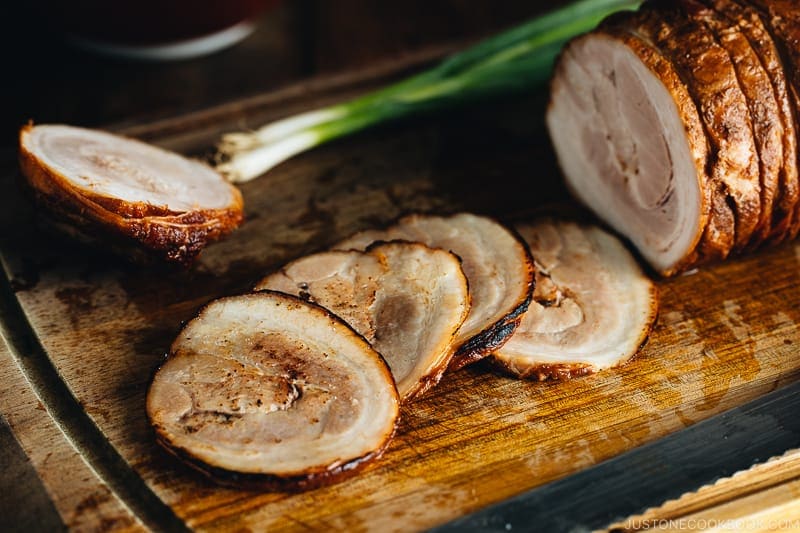
How To Make Chashu Pork
- Roll and tie the pork belly block into a log with kitchen twine (see the sections below for instructions) or skip rolling by using smaller blocks.
- Sear the pork belly over high heat in a heavy bottomed pot to brown the surface of the meat.
- Simmer and braise the meat in a soy sauce-based seasoning on low heat for about 1–2 hours. The sauce will reduce and concentrate during this time.
- Transfer the meat to a bag or container and pour in some cooking sauce. Let rest overnight in the refrigerator to marinate.
- The next day, it’s ready to serve. Slice the chashu thinly but thick enough for the chopsticks to clasp on.
How To Slice Chashu
It’s pretty easy to cut the chashu into thin slices once it has a chance to rest and chill in the refrigerator overnight. A sharp bread knife makes the task easier, too.
I don’t usually use up the entire chashu in one meal. I usually cut it into several thin slices for ramen, and then cut the rest into 2 to 3 blocks and pack each piece in a Food Savor bag to store in the freezer. I’ll show you in a later section the various ways to enjoy chashu.
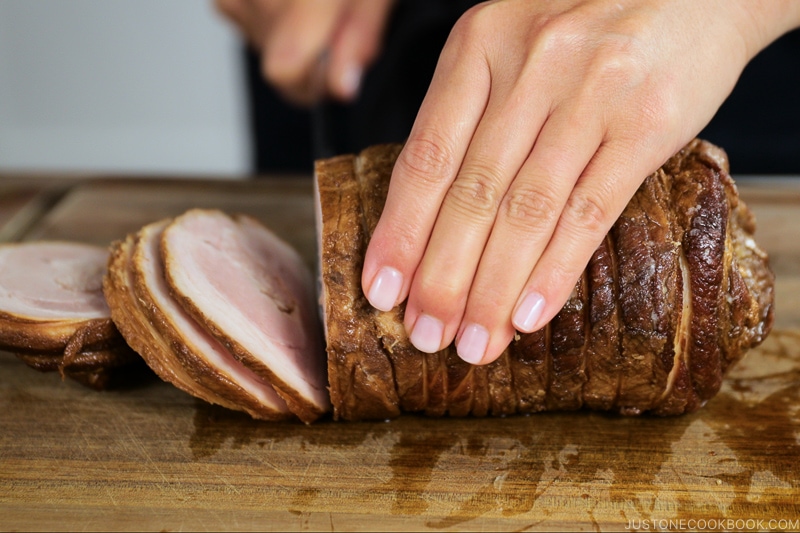
How To Reheat Chashu
There are 3 ways to reheat chashu:
- Soak the chashu slices in hot cooking sauce.
- Directly add it to your bowl of ramen or hot noodle soup.
- Sear using a culinary butane torch. We call this aburi chashu (炙りチャーシュー), as aburi means searing in Japanese.
I use the searing option to reheat and add smoky charred flavor. Don’t forget to drizzle some hot cooking liquid on top!
3 Tips for the Best Chashu
- Sear the meat well. This step makes a great difference, enhancing the finished dish with complex layers of flavor. My go-to choice for searing meats is a solid cast iron pan. You can really turn up the heat with cast iron and the food comes in direct contact with an evenly heated surface.
- Don’t skip the ginger and long green onion. These ingredients help remove any unsavory odor and add more depth to the sauce.
- Rest the pork overnight. After slow cooking in the pot, the pork belly marinates for 8 hours in the fridge to soak up all the flavor of the braising liquid. Along with the slow cooking, this overnight resting period is crucial to help intensify the chashu’s flavor.
Chashu Rolled (Log) vs. Non-Rolled (Block)
Chashu served on ramen is often the rolled type, although many ramen shops in Japan do serve slices of the non-rolled chashu. Both ways are legitimate chashu by the standard of ramen shops. Let’s take a look at the two options.
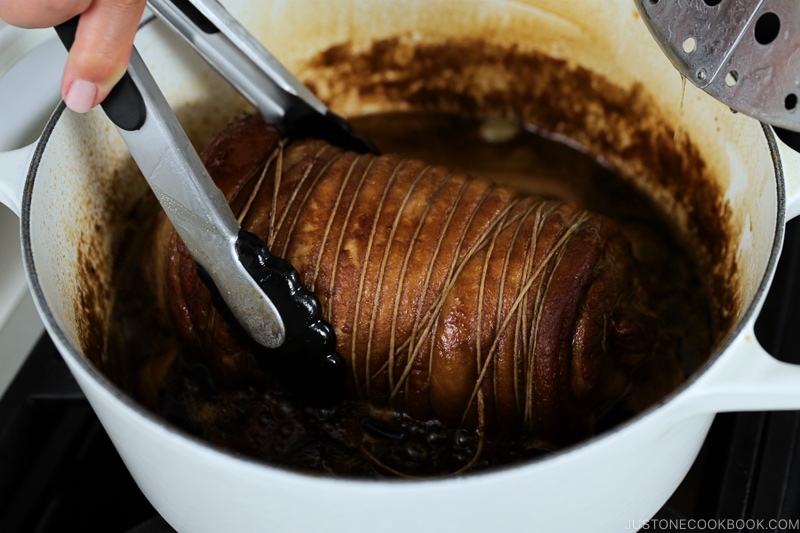
Rolled Chashu (Log)
For serving on ramen, the most common preparation for chashu is rolling a big slab of pork belly into a log with butcher’s twine. Here’s why we roll chashu:
- to maintain its shape after rendering the fat
- to keep the pork moist – since the meat inside is not directly exposed to the sauce, it absorbs the flavor without drying out.
- to look attractive
For this method, I increase the cooking time compared to the non-rolled type since we need more time to rotate the chashu and soak up all the good flavor.
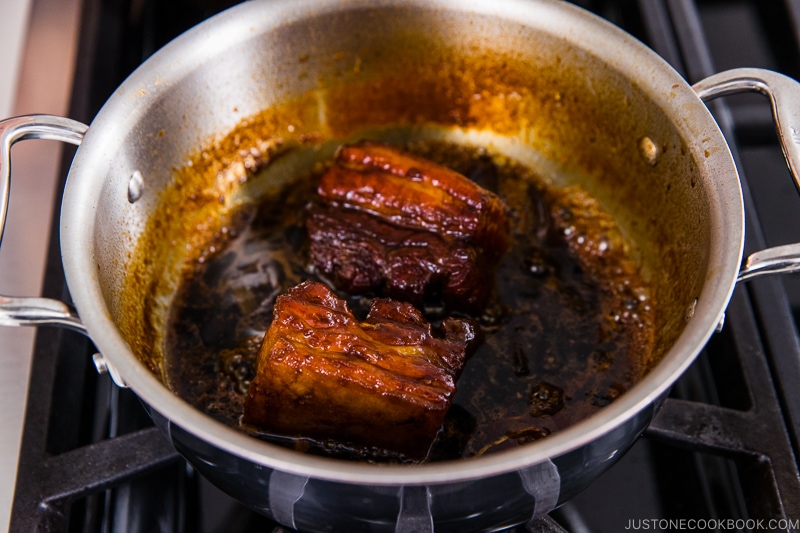
You may wonder why I don’t increase the seasoning to completely submerge the chashu in liquid. This is how ramen shops cook chashu everyday, combining yesterday’s cooking sauce with a new batch of seasoning.
However, to a home cook, it is rather wasteful to make such a big batch of cooking sauce. That’s why my recipe requires 2 hours to cook rolled chashu as opposed to 1 hour for the non-rolled type.
Non-Rolled Chashu (Block)
If you want to make less chashu, consider making non-rolled chashu with smaller blocks of pork belly:
- good choice for a smaller portion – The pork belly blocks I buy from the local Japanese supermarket come in pieces about ¾–1 lb.
- start searing right away – you can skip the rolling and tying step!
- shorter braising time – just 1 hour! The slab is fairly flat and easily absorbs flavor. Make sure to use an otoshibuta (drop lid) so that the sauce circulates nicely and won‘t evaporate too much.
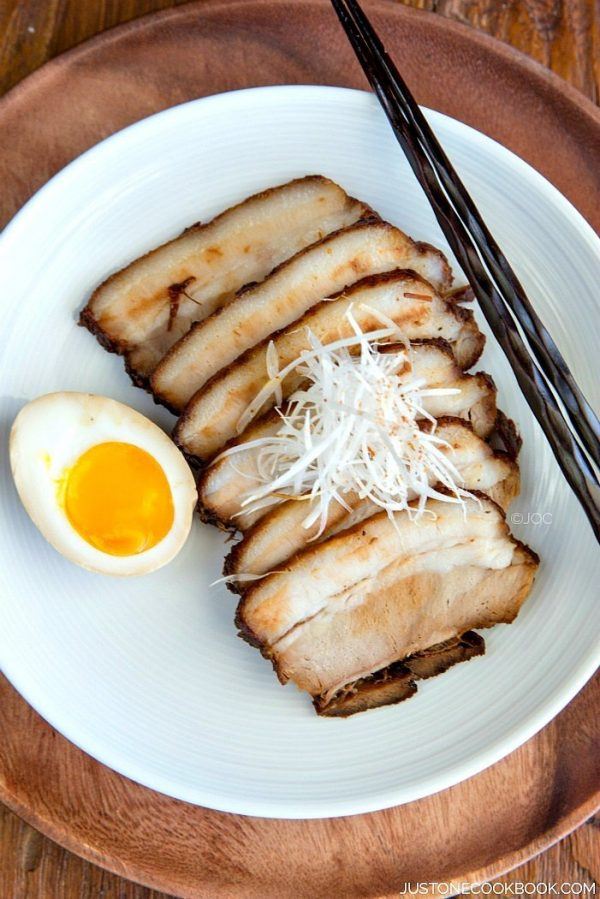
Chashu (non-rolled chashu) served with shiraga negi topping and ramen egg.
How To Roll and Tie Pork Belly
You can find the step-by-step pictures in the recipe and video, but here’s a quick summary:
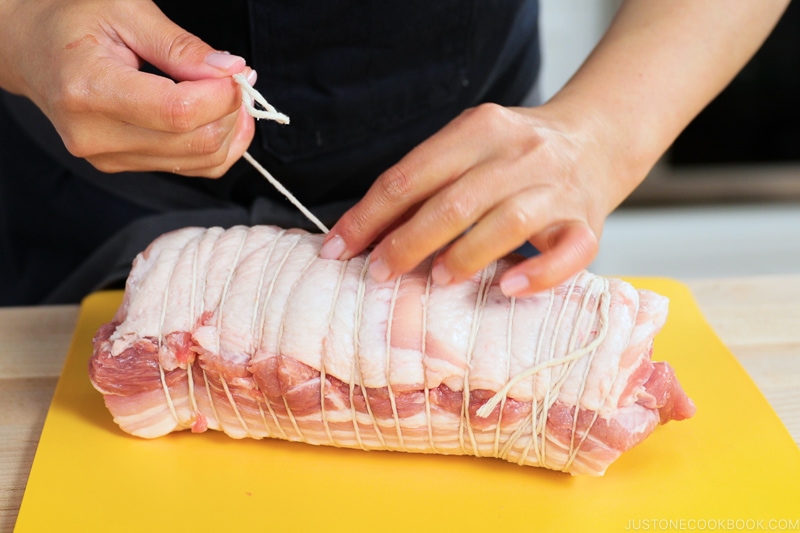
- Find the right orientation for rolling. One or both ends should have a “bacon”-like appearance, showing the varying layers of meat and fatty parts.
- Roll up and find how much pork belly you need for a nice cooking chashu. Set on a cutting board and cut off any extra meat (save it for other recipes).
- Once you roll up the pork belly into a log, tie the meat with butcher twine on one end and make a double knot.
- Wrap 2–3 more times on the same end (the starting point) to make sure it is secured.
- Then run the twine across the log to the far end and wrap 2–3 times tightly. Both ends are now secured.
- From this end, start wrapping tightly and work toward the starting point, keeping ⅓ inches (1 cm) between each wrap.
- Once you reach the starting point, run the twine under some wraps around the middle and then bring back to the starting point.
- Make a double knot with two ends of the kitchen twine.
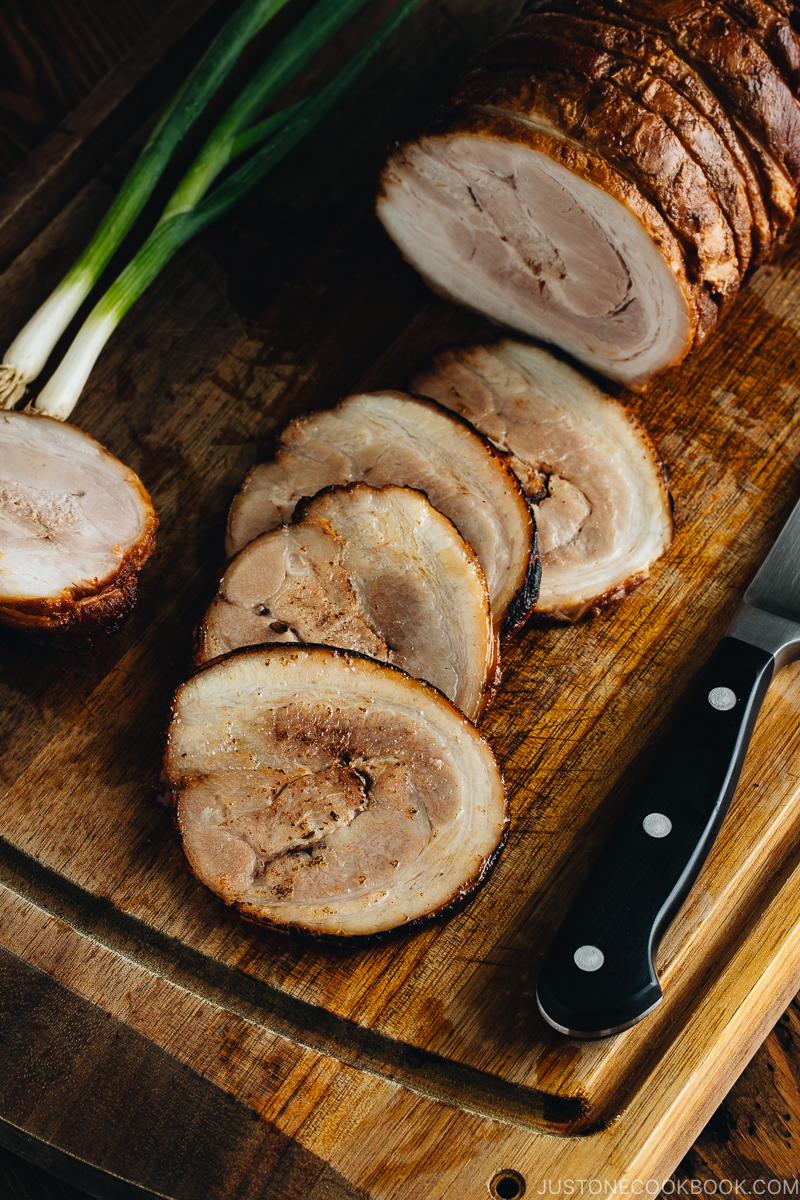
The Best Cut of Pork for Chashu
The ideal cut for chashu is pork belly, although you can use pork shoulder, and sometimes pork loin. Keep in mind that the last two choices don’t get the melt-in-your-mouth texture as they do not have as much fat as pork belly.
In Japanese cooking, we usually use pork belly without a rind/skin (except for making certain Chinese or Okinawan recipes).
I always use pork belly for my Chashu recipe, but if you try pork shoulder, let me know. I personally would not recommend using pork loin for this recipe.
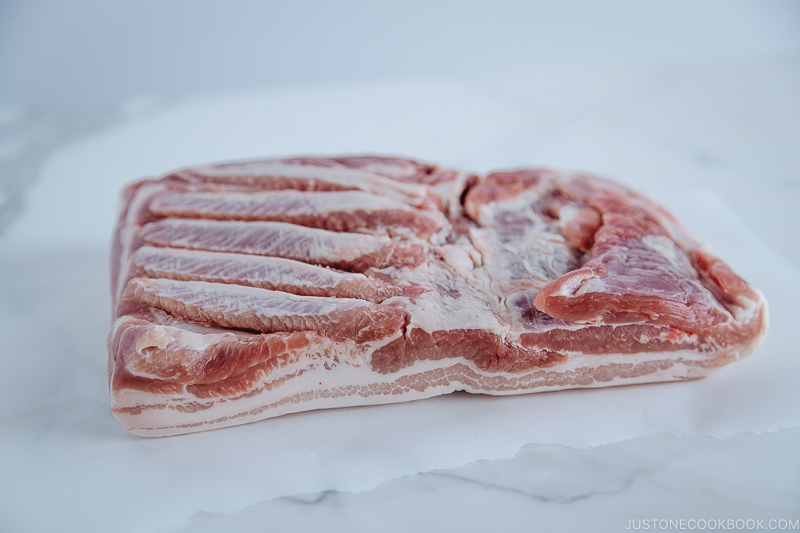
Where To Buy Pork Belly
You may not find pork belly sitting at the butcher window or sold pre-packaged, but most butchers should have them stored in the freezer. So don’t be shy to ask the butcher at your local grocery stores or meat deli. Ready to make pork belly on the same day? Do call ahead and factor in the defrosting time as they usually come frozen.
The best place to shop for pork belly is Korean grocery stores. They sell different thicknesses and sizes of pork belly. I usually request the butcher to cut a specific size just for me.
You can also ask the butcher to remove the rind/skin (if there is any) or remove it yourself using a sharp knife.
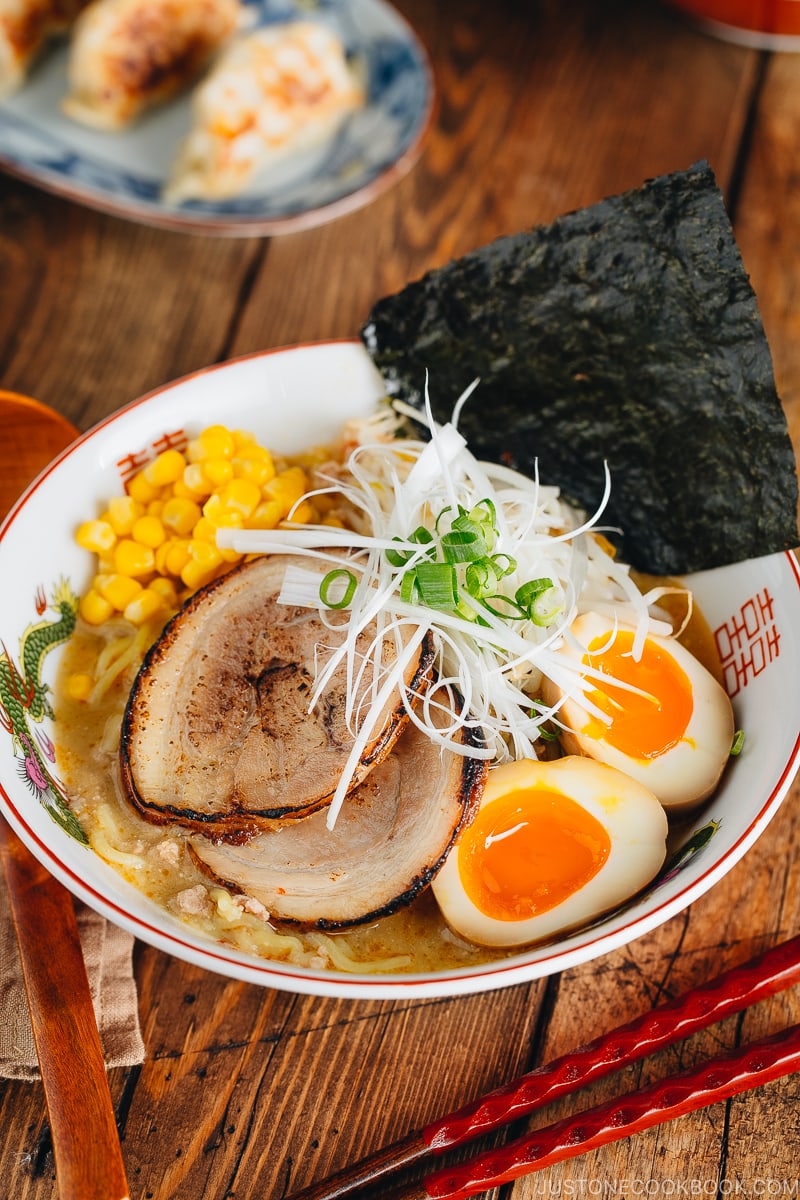
How To Enjoy Chashu
Besides enjoying chashu with ramen or as a main dish, you can also use it for many other dishes. Here are my suggestions:
- Noodle dishes – Hiyashi Chuka and Tsukemen
- Rice dishes – Chashu Don (over rice) and Chashu Fried Rice, a great way to use up the broken pieces or edges of Chashu.
- Sandwiches and buns – Serve in steamed pork buns called Nikuman
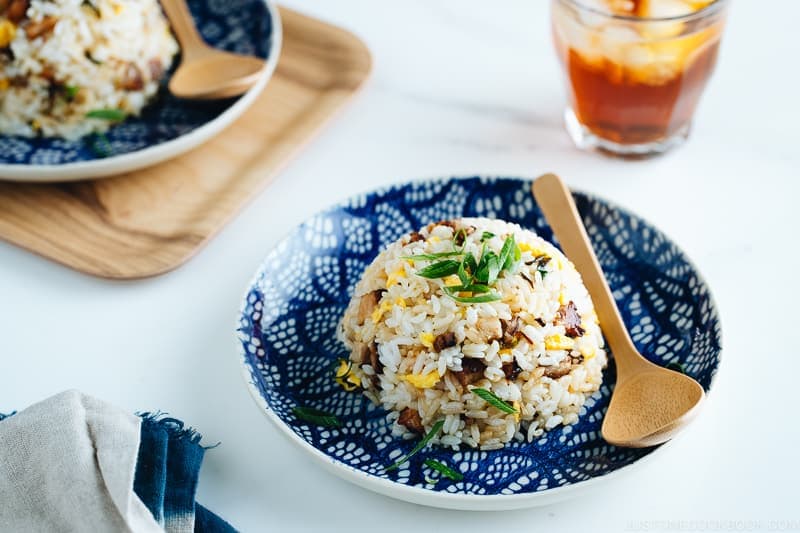
How To Use Leftover Chashu Sauce
- stir-fry seasoning
- marinade for grilling meat
- marinade for Ramen Egg (ajitsuke tamago)
A Long-time Family Favorite Recipe
I’ve been cooking this exact chashu recipe for almost 20 years (it’s been on the blog since 2011). My family loves it. It’s not that difficult to make at all, but you may need to be around in the kitchen while simmering the meat. The final reward is phenomenal and it’s totally worth your time!
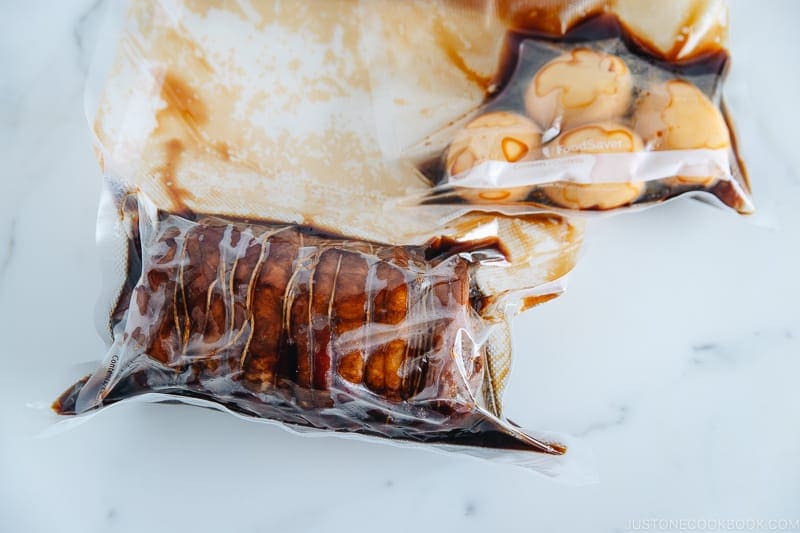
Wish to learn more about Japanese cooking? Sign up for our free newsletter to receive cooking tips & recipe updates! And stay in touch with me on Facebook, Pinterest, YouTube, and Instagram.
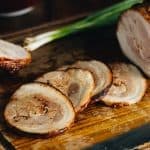
Chashu (Japanese Braised Pork Belly)
Video
Ingredients
For a Rolled Chashu Log (serves 8–10)
- 1 pork belly block (2–2½ lb, 907–1134 g; roughly 8 x 9 inches, 20 x 23 cm each; remove the rind from your pork belly)
- 1 Tokyo negi (naga negi; long green onion) (green part only; substitute with 1 leek or 2–3 green onions)
- 4 slices ginger
- 1 Tbsp neutral oil (for searing)
- 1 cup sake
- 1 cup soy sauce
- 2 cups water
- ⅔ cup sugar
For a Non-Rolled Chashu Block (serves 3; this is my original recipe posted on May 2011)
- ½ Tbsp neutral oil (for searing)
- ¾ lb pork belly block (for 1 lb (454 g) of meat, see Notes)
- 1 Tokyo negi (naga negi; long green onion) (green part only; substitute with 1 leek or 2–3 green onions)
- 4 slices ginger (from 1-inch, 2.5-cm knob)
- ⅓ cup sake
- ⅓ cup soy sauce
- ⅔ cup water
- 3 Tbsp sugar
Instructions
FOR ROLLED CHASHU (Scroll down for the NON-ROLLED version)
- Before You Start: Please note that this rolled Chashu recipe requires an overnight resting time of 8 hours.
DAY 1
- Gather all the ingredients.
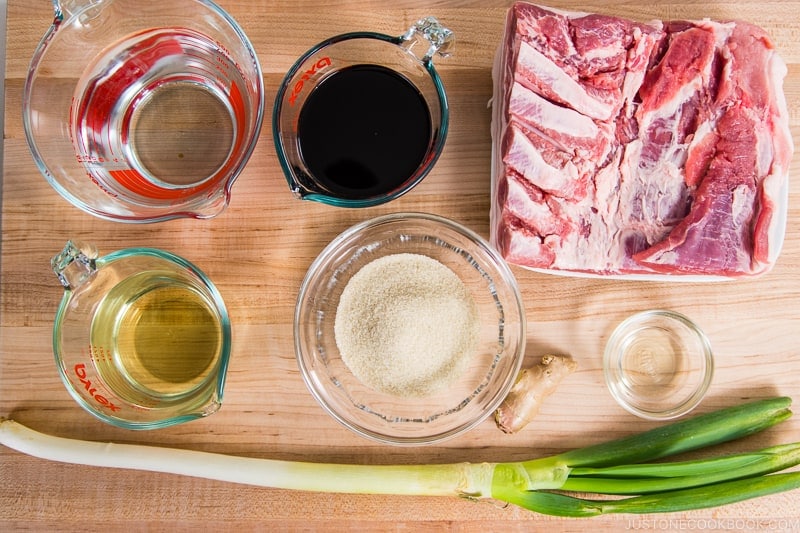
To Prepare the Pork Belly
- Roll up your 1 block of pork belly (2–2½ lb or 907–1134 g). Make sure one or both ends have a “bacon-like“ appearance, showing the varying layers of meat and fat. If your slab comes with the rind, remove it or ask your butcher to do it for you.
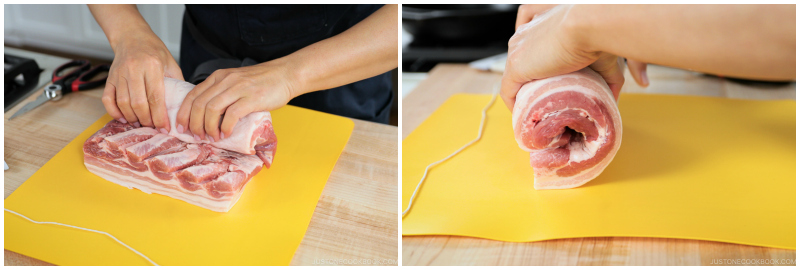
- Run some butcher twine under the far end of the log. Tie a double knot to secure the rolled end tightly. Make sure you leave a tail of about 3 inches (7.5 cm) of twine at the end.
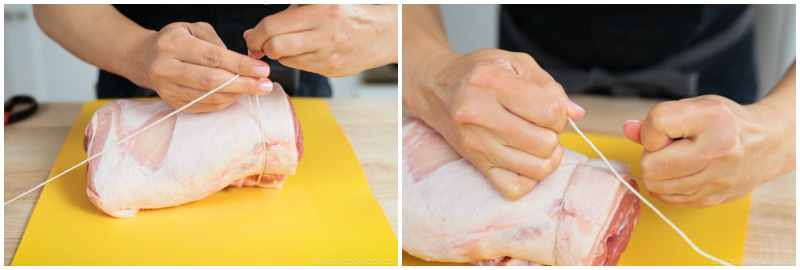
- Next, tightly wrap the twine around the spot you just tied another 2 or 3 times to secure the starting point of the roll. Then, pull the twine to the opposite end of the pork belly roll. Tightly wrap the twine around that end 2 to 3 times to secure it.
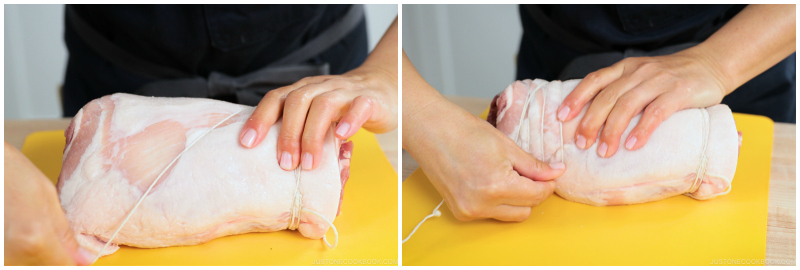
- Next, start wrapping the twine around the roll back toward the starting point. Space each wrap ⅓ inch (1 cm) apart. Make sure you wrap the roll as tightly as possible.
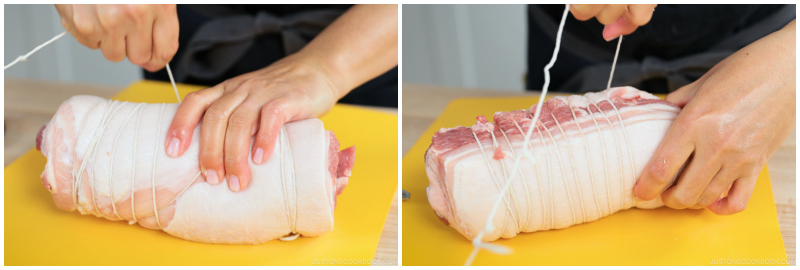
- Once you reach the starting point, run the twine under some of the end wraps; this hooks the twine in place so you can reverse direction. Next, run the twine under 4 or 5 wraps going away from the starting point. Then, double back toward the starting point, running your twine under the wraps until you reach the original double knot.
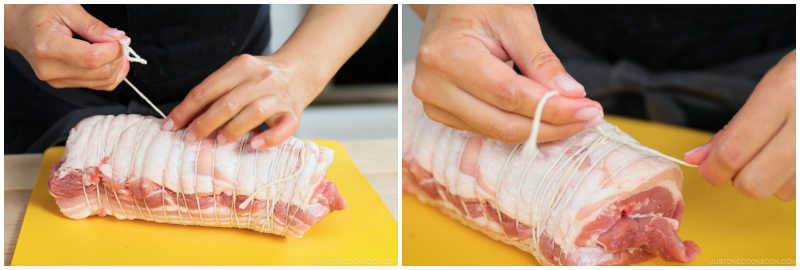
- Find the 3-inch tail of twine that you left when you started. Tie a double knot with the tail and the long end of the twine, and cut the excess.
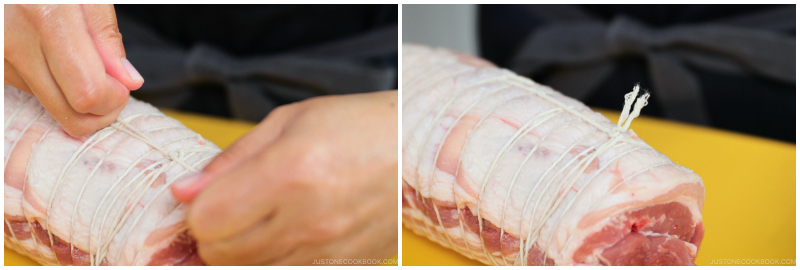
To Cut the Aromatics
- Cut the green part of 1 Tokyo negi (naga negi; long green onion) and set aside; reserve the white part for another use. Cut 4 slices ginger (unpeeled).
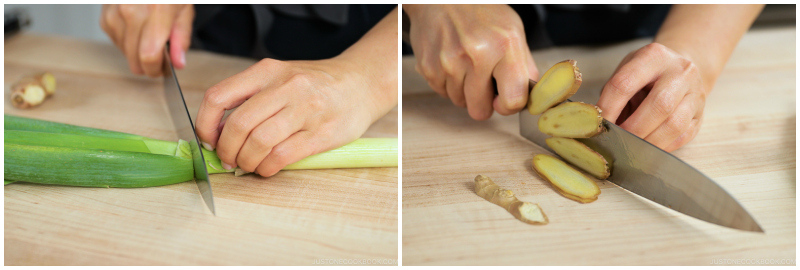
To Sear the Pork Belly
- Heat 1 Tbsp neutral oil in a cast-iron skillet (or regular frying pan) over high heat. Add the tied pork belly to the skillet.
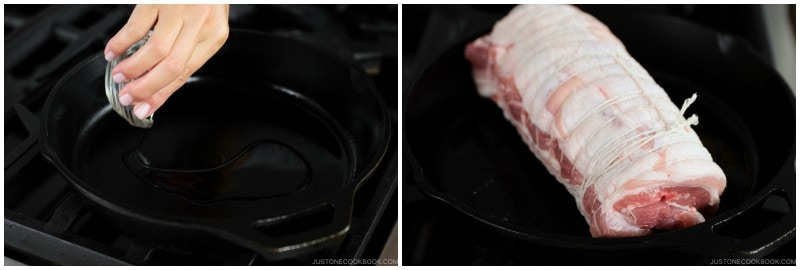
- Sear the pork belly one side at a time, rotating it to make sure all sides are golden brown.
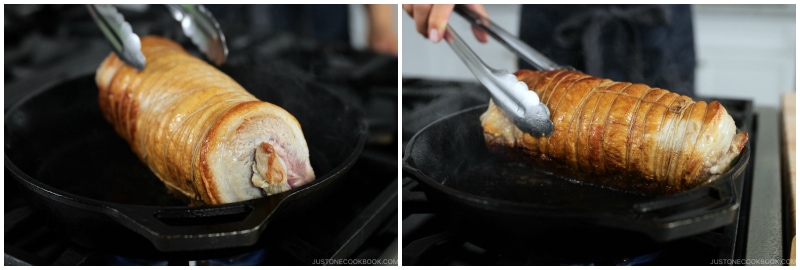
- It’ll take about 10–15 minutes all together.
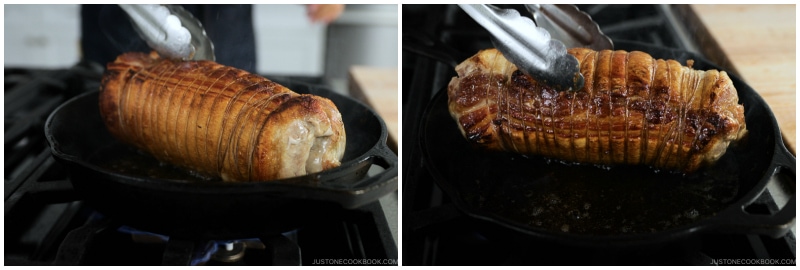
To Prepare the Braising Liquid
- While the pork is searing, prepare the braising liquid. Put 1 cup sake, 1 cup soy sauce, 2 cups water, and ⅔ cup sugar in a heavy-bottomed pot (I used a Dutch oven) that will fit the chashu. Then, add the Tokyo negi (green part) and 4 slices ginger.

To Simmer the Chashu
- Transfer the seared chashu roll to the Dutch oven.
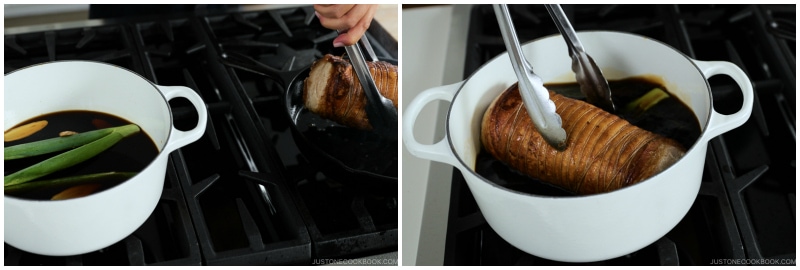
- Bring the liquid to a boil over medium heat.
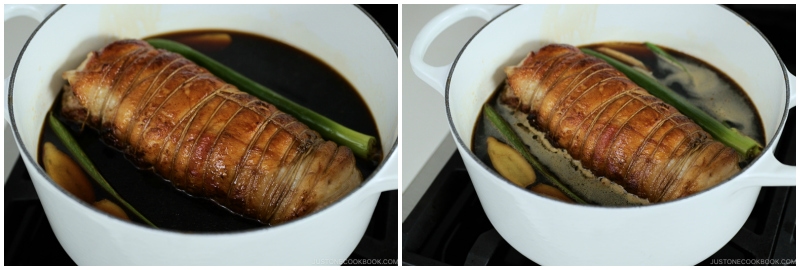
- Once boiling, skim off the foam and scum. Then turn the heat to low/simmer.
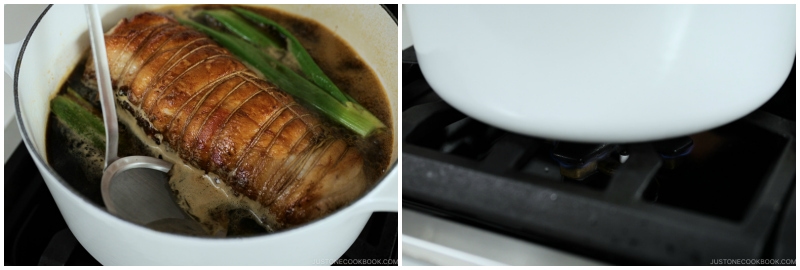
- Put an otoshibuta (drop lid) on top to press the ingredients down and limit the evaporation. You do not need to use a regular lid to control the evaporation. If you don’t have an otoshibuta, you can make one with aluminum foil (here’s how to make the otoshibuta).
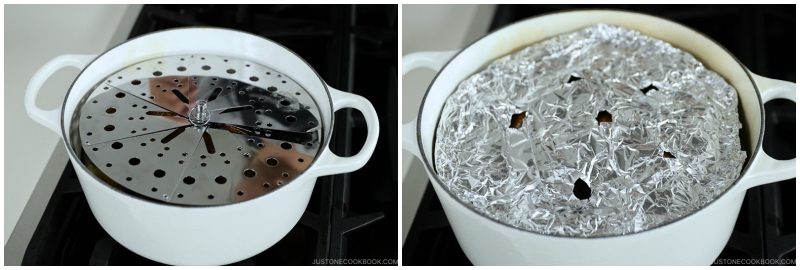
- Simmer on low heat, and cover with the otoshibuta at all times for the next 2 hours, turning the chashu every 30 minutes.
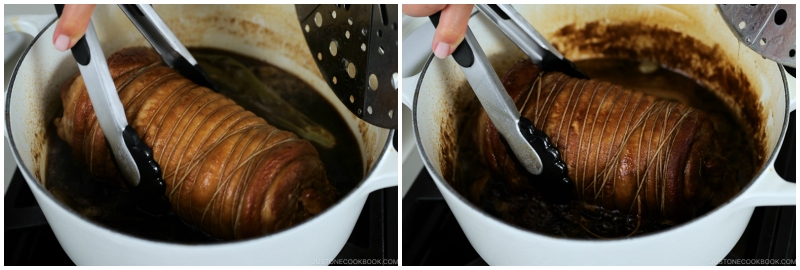
- After 2 hours, the braising liquid has reduced a bit. Turn off the heat to let the chashu roll cool a little bit.
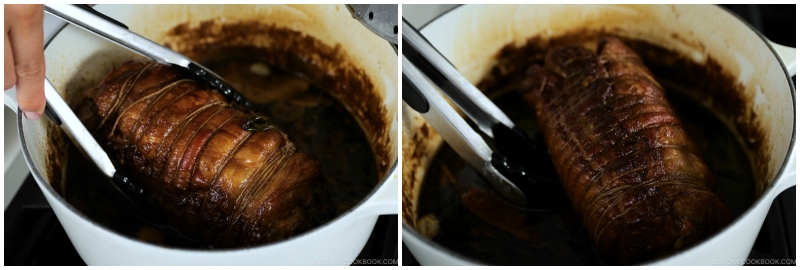
To Rest the Chashu Overnight
- Once the meat is slightly cooled, transfer it to a container or a plastic food vacuum-sealing bag, such as one for the FoodSaver system. (If you‘re doubling or tripling this recipe, put each chashu roll in its own bag.) Strain the leftover cooking liquid through a fine-mesh strainer.
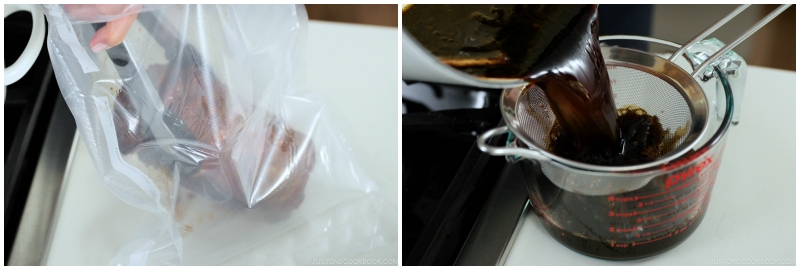
- Add ½ cup of the cooking liquid into the bag. If using a container, add about 1 inch (2.5 cm) of the braising liquid to the bottom and cover.
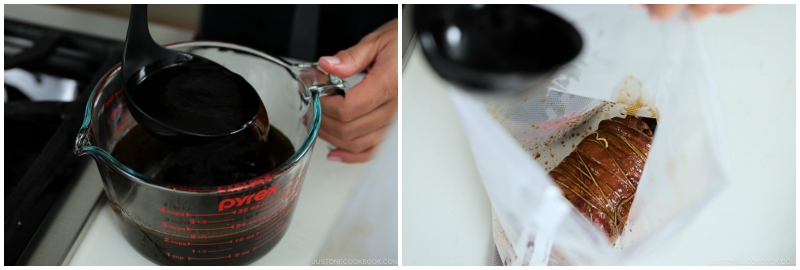
- If using the FoodSaver bag, seal it with a FoodSaver sealer. Tip: Fold a piece of paper towel to plug the entry of the FoodSaver bag. This paper towel will absorb any extra moisture when you seal.
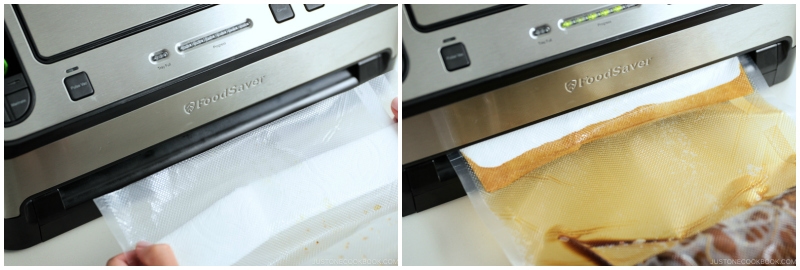
- Tip: I also made quick Ramen Eggs (Ajitsuke Tamago) with the leftover liquid. Simply cook and peel soft-boiled eggs, add them to a bag with ½ cup of the cooking liquid, and close. Cover the cooking liquid, and store the chashu, ramen eggs, and the cooking liquid in the refrigerator.
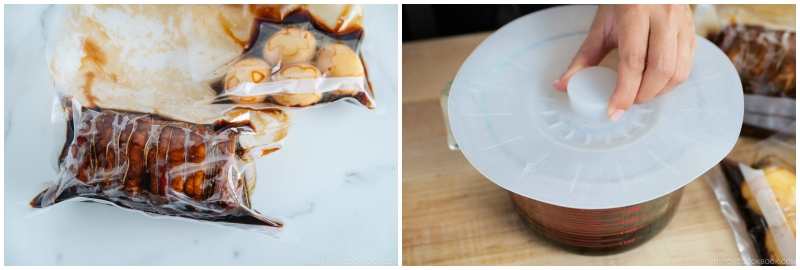
DAY 2
- Open the bag of chashu.
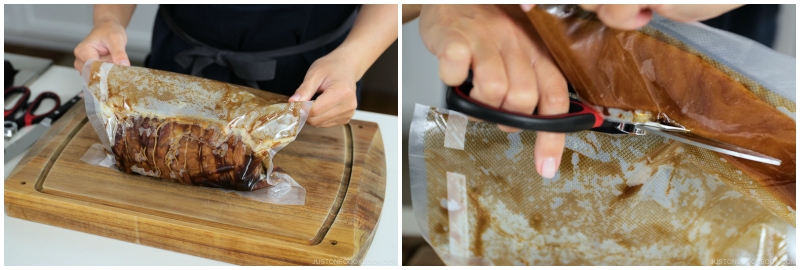
- Cut the twine with kitchen shears and remove the twine pieces completely.
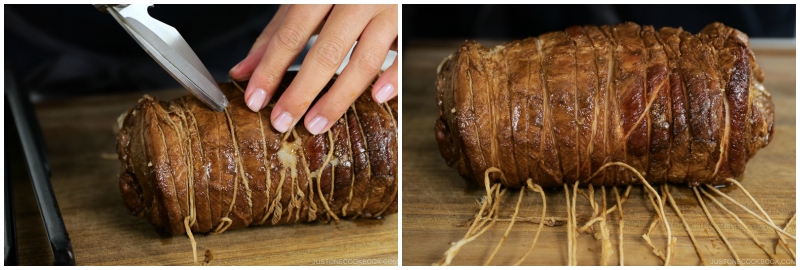
- Slice the chashu into ¼-inch pieces and keep the end piece for Chashu Fried Rice!
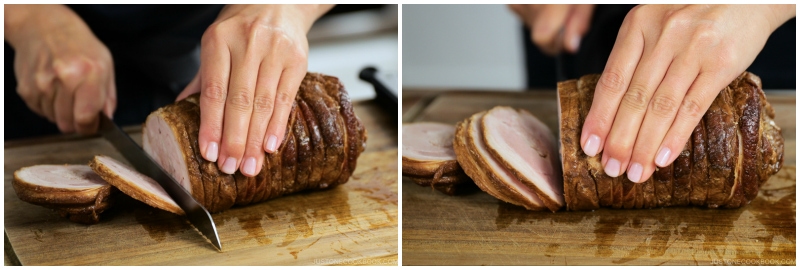
- Place the chashu slices on a ceramic plate. Sear and enhance the flavor with a kitchen butane torch. You can also use a broiler in the oven. Enjoy them immediately or serve on your ramen.
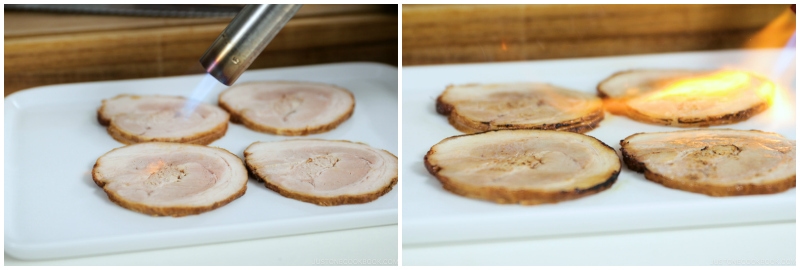
- Scoop up and discard the solidified fat from the cooking sauce.

- Strain the sauce over a fine-mesh sieve to make sure the solidified fat is left behind. Pour the sauce into a mason jar or container and seal. The sauce will last for a month in the refrigerator. I use it for drizzling over the chashu and for making stir-fried dishes, marinades, and ramen eggs.
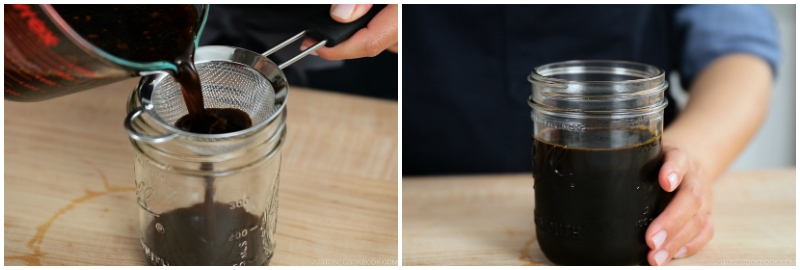
To Store
- You can store the chashu in the refrigerator for up to 7 days or 1 month in the freezer. I usually divide the rolled chashu into thirds and freeze 2 portions separately (for ramen right away, and Chashu Fried Rice and Chashu Bowl for later). Ramen Eggs should be consumed in 3–4 days if they are soft-boiled eggs and 7 days if hard-boiled eggs. The eggs get saltier the longer you keep them in the marinade, so remove them from the sauce when they have the right taste.
FOR NON-ROLLED CHASHU
- Gather all the ingredients. For small blocks of pork belly (about 1 lb) like I‘ve used here, you don’t need to roll them up before cooking, and the simmering time is just 1 hour (instead of 2 hours). Tip: To cook 1 lb (454 g) of pork belly, see the ingredients list in the Notes section at the end of the recipe card.
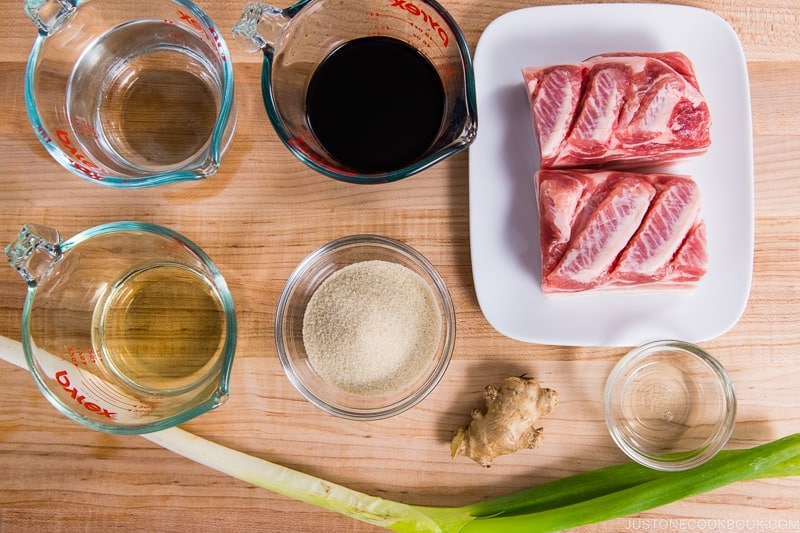
- Heat a cast iron skillet (or regular frying pan) over high heat. When the pan is hot, add ½ Tbsp neutral oil. Sear ¾ lb pork belly block fat-side down first, then flip over to sear the other side; this will take about 10 minutes.
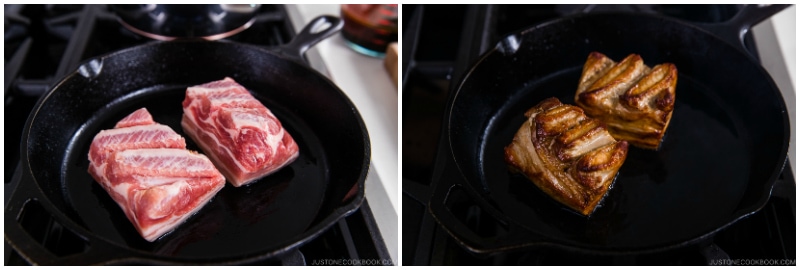
- While searing, prepare a heavy-bottomed pot (or regular pot) that will fit the chashu. To the pot, add the green part of 1 Tokyo negi (naga negi; long green onion), 4 slices ginger (unpeeled), ⅓ cup sake, ⅓ cup soy sauce, ⅔ cup water, and 3 Tbsp sugar. Once you‘re done searing the meat, add it to the pot. Bring the liquid to a boil, skimming the scum and foam. Then, turn the heat to low/simmer.
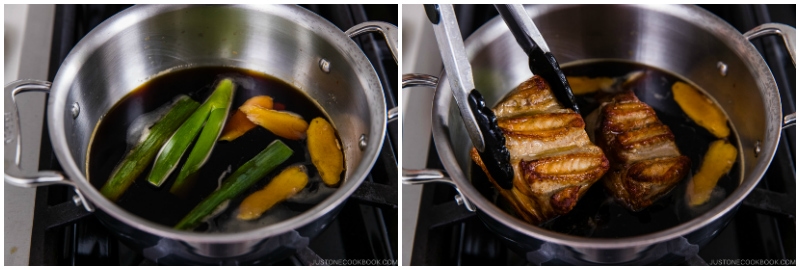
- Put an otoshibuta (drop lid) on top to press the ingredients down and limit the evaporation. If you don’t have an otoshibuta, you can make one with aluminum foil (here’s how to make otoshibuta). Simmer on low heat for 1 hour, turning the chashu every 15 minutes and keeping an otoshibuta on at all times.
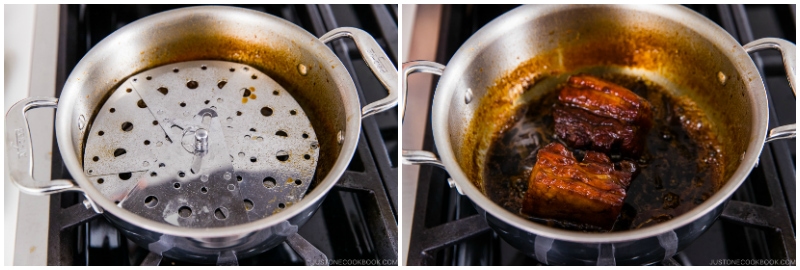
- After 1 hour, there is ½ inch of liquid left in the pot. Now, you have 2 options. Option 1: If you’re serving it right away, remove the otoshibuta and further reduce the sauce on low heat until the sauce thickens and you can see the bottom of the pot when you draw a line through the sauce with a spatula. Option 2 (recommended): Transfer the chashu to a container or bag with a little bit of cooking sauce and refrigerate overnight. Strain the leftover cooking sauce, transfer to a jar, and refrigerate.
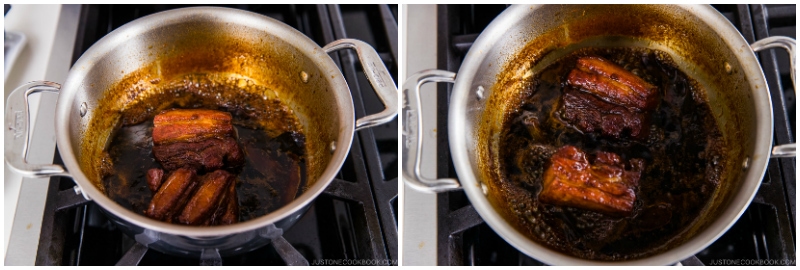
- To serve, slice the chashu into ¼-inch (6 mm) pieces. Sear and enhance the flavor with a kitchen butane torch. If you stored the chashu overnight and don’t want to sear the chashu, you can reheat it by soaking it in hot cooking sauce.

Notes
- 1 lb pork belly block (454 g)
- 1 negi (long green onion) (substitute with 1 leek or 2-3 green onions)
- 1 knob ginger
- ½ Tbsp neutral-flavored oil (vegetable, canola, etc.)
- ½ cup sake (120 ml)
- ½ cup soy sauce (120 ml)
- 1 cup water (240 ml)
- ⅓ cup sugar (75 g, 5 Tbsp)
Equipment
Nutrition
Editor’s Notes: This post was originally shared in May 2011. The first video was added in September 2014 with new images. New video and images are added in May 2019.
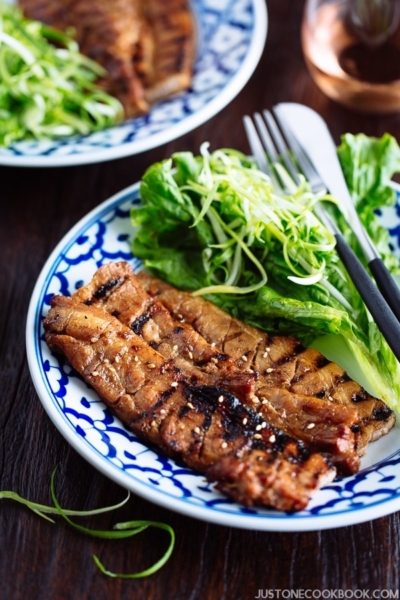
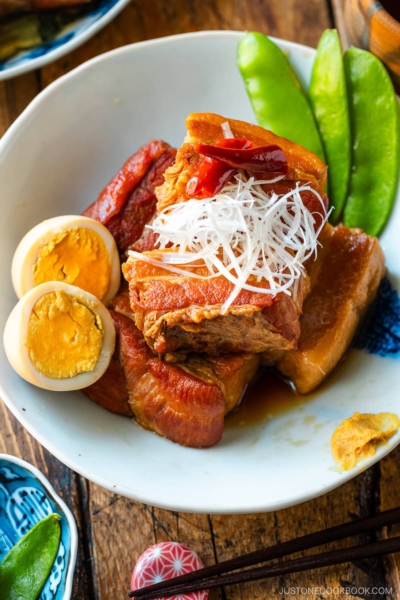
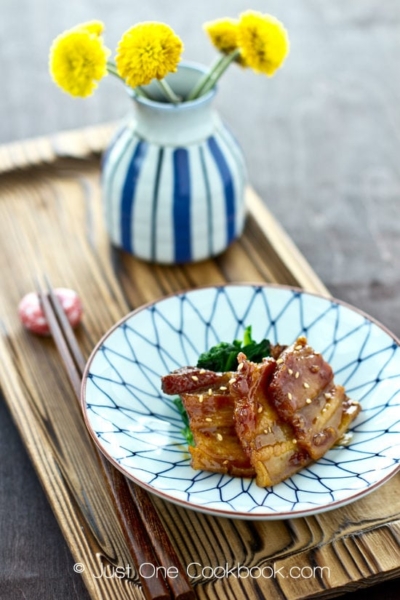
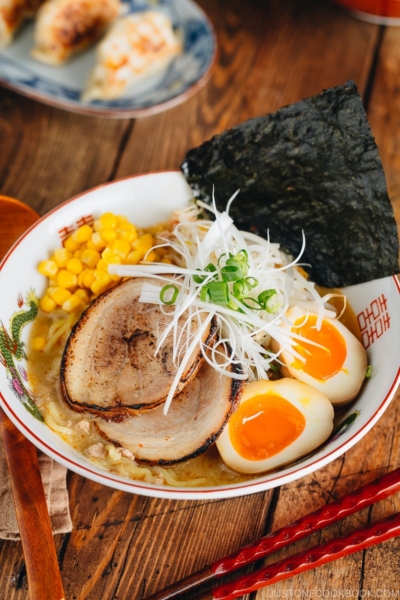





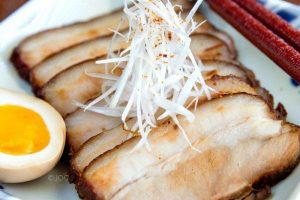
Guys this was soooo good, easily one of the best meat dishes I’ve ever prepared. I made an otoshibuta out of aluminum foil and broiled the slices when marinated the next day, and it may have even been better than the Tonkotsu Ramen recipe from JOC I made to go with it. I would eat it straight up if we had any leftovers! Would recommend doubling the recipe because it goes fast.
Hi, Madi! Thank you for trying Nami’s recipes. We’re happy to hear you enjoyed the Chashu!
Thank you for sharing your experiences and encouragement! Happy cooking!
This recipe was actually amazing. I did have a hard time skinning the pork belly and tying the twine myself. My smoke detector was also decidedly very not happy with the searing step. Searing at the end with a butane torch gave an amazing smoky, charred flavor; definitely don’t skip out on this.
Hello, Emily! Thank you for trying Nami’s recipe and sharing your experience with us!